Fly Fishing for Salmon in Southeast Alaska
- Bear River Tackle

- Jun 9, 2020
- 10 min read
By Glenn Personey, President of Bear River Tackle
Introduction
Thirty years ago, we decided to put together a self-guided fishing trip to Alaska. Our usual summer fly fishing trip was to one of the rivers in the western United States with a pass through Yellowstone.
On that first Alaska trip, when we had no idea what we were doing, more big fish were landed than during the previous ten years of fishing in the West. After that, the majority of our focus has been on learning to fish Alaska.

Photo by Glenn Personey
Cultures
The region is a mix of Native American, Russian and Scandinavian cultures generally located in different areas but sometimes mixed together in the same place.
Each has its own traditions and important sites. Please remember you are a guest in their home; respect their traditions and protect the wild lands you encounter. Alaska is a special place.

Depositphotos
These are totem poles carved by Native Americans who have an ancestral marine culture. Notice the whale and eagles.
Access
The area is bounded by ocean on one side and mountains on the other. Access is possible only by boat or plane and many of the remote fishing areas can only be reached by float plane.
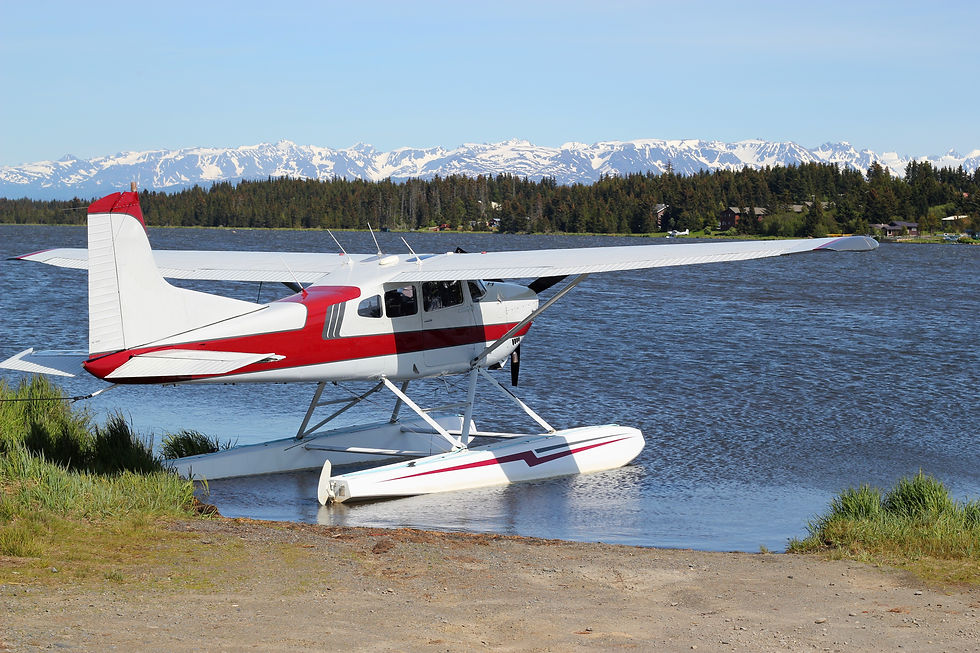
Depositphotos
If you are considering a float plane trip, be sure to research the safety record of the company and ensure they know the flight path to your destination. There is a saying in Alaska that there is no such thing as an “old bold float plane pilot.” Even a careful pilot can have a close call.
Even with a good pilot we have emerged from heavy clouds almost on top of trees; made a second takeoff run because the first pass was too low; followed a river to find our destination; and been delayed due to low cloud ceiling. There is a lot that can go wrong on a float plane trip so plan on being flexible.
Fishing Opportunities
Southeast Alaska has almost unlimited fishing opportunities, starting with hundreds of rivers and streams all of which have salmon runs.

Depositphotos
Some of the streams also have Steelhead runs as well as Cutthroat trout, Dolly Vanden and Grayling. Saltwater fishing includes Halibut, Rockfish and Lingcod.
Salmon Types
Five different types of salmon can be caught in Alaska during summer and fall. These include:

Photo by Glenn Personey
Coho (Silver) salmon, which are 10-15 pounds. They will take a fly when properly presented, but the strike is usually very subtle. When hooked, they will jump out of the water, spin your reel handle backward and are difficult to land.

Photo by Mike Wirth
Chum (Dog) salmon are 10-20 pounds and will readily take a fly but the strike may be light. They are strong fish that will put up a tremendous fight.
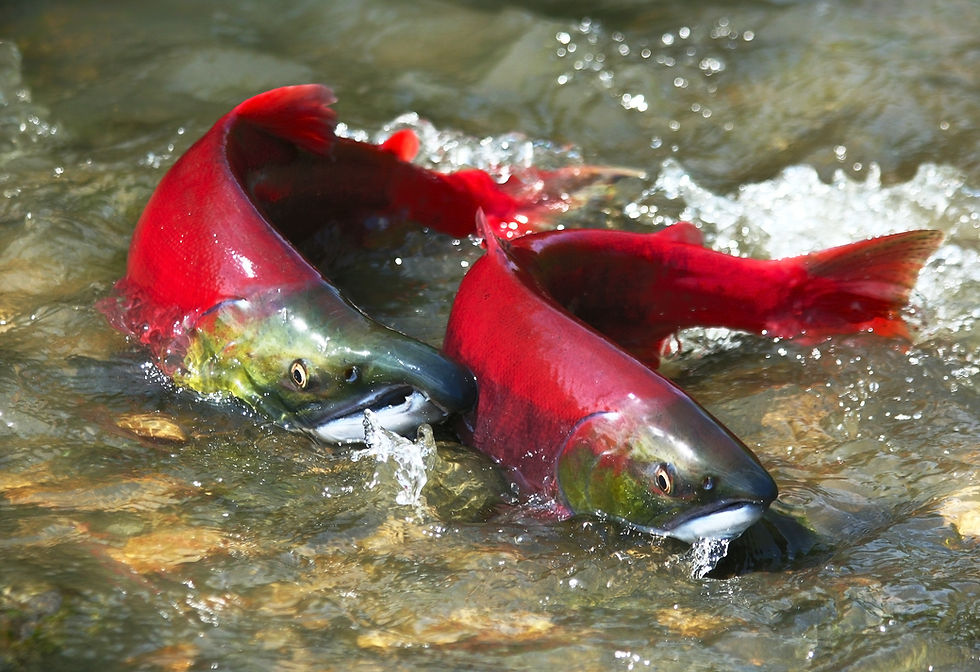
Depositphotos
Sockeye (Red) salmon are 6-8 pounds and are difficult to catch on a fly. You almost have to floss them to place the fly in their mouth.

Photo by Mike Wirth
King salmon are 20-50 pounds, not very numerous and only found in major rivers. They will take a fly, but the strike can be subtle, and they are difficult to hold on a fly rod.
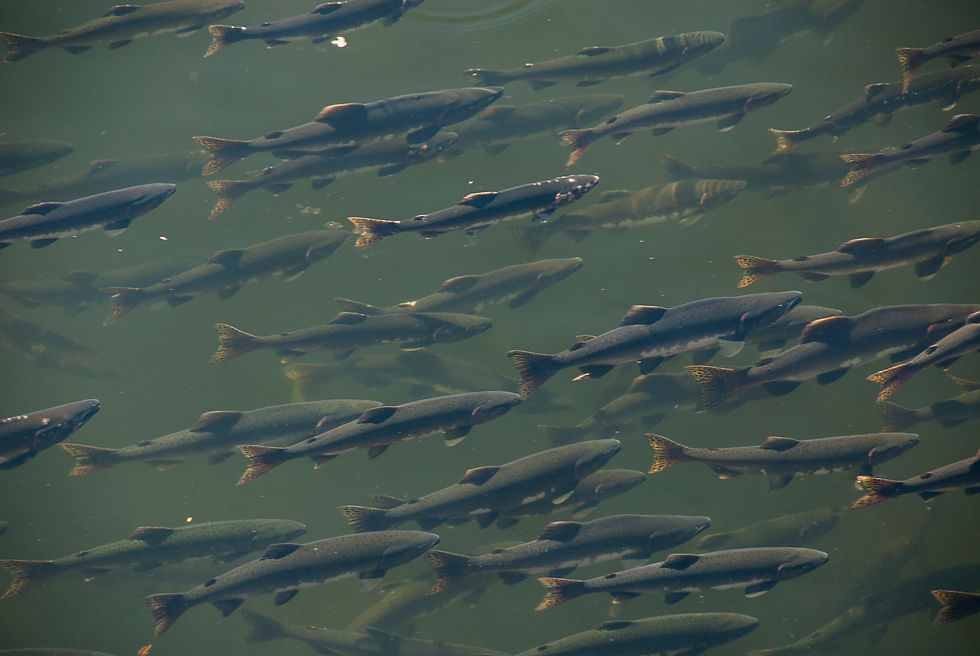
Depositphotos
Pink (Humpy) salmon are the smallest of all the salmon but they are very numerous and still weigh 3-5 pounds! Virtually all of the streams have a pink salmon run and they are relatively easy to catch on flies. On many trips I have landed more than 50 per day.
Timing of the Runs
Timing of the runs in each stream will determine whether you catch fish. Go too early and there will literally be no fish in the water. Go too late when the run is complete, and the salmon will be dying.
The runs for each type of salmon start at different times and the timing of the runs in each stream can also be different so it is best to check with a fish biologist from the Alaska Department of Fish and Game for the area you are interested in before planning your trip.
· King: June – July
· Sockeye: July-August
· Pink: August
· Dog: August – September
· Coho: August – Early October
Weather
Salmon depend on adequate flow of water in the rivers to complete their spawning run so they will not start migrating without sufficient rain. If there is low water in the streams large schools of fish will mill around in saltwater and wait. This is what adequate stream flow looks like:

Depositphotos
There is nothing you can do about the weather when planning your trip other than to be aware that rainfall is heavier as Summer turns to Fall.
On one fly-in trip the float plane landed, we unloaded our gear and watched the plane fly off before we looked at the river. It was a shock to see there were literally no fish in the stream.
This was a particular problem because we were counting on grilling one salmon per day as a major part of our food supply. Fortunately, the fish were queued up in saltwater and we could reach them with spinning gear for the first few days; then it started to rain, and we switched to flyrods as the run began.
It is also possible to have too much flow in the river. In this situation the salmon will blow through all of the pools, it will be difficult to keep the fly down in the strike zone and wading can be treacherous. This is a good time to switch over to large spinners and heavy spoons if you want to catch fish.
Clothing and Gear
The weather can be anything from 75 degrees and sunny to 50 degrees and rainy so pack clothing that can be added in layers.
It is especially important to bring multiple waterproof and breathable wading jackets; one to hang up and dry while the other is in use.
The water can be blindingly bright on sunny days, so a quality pair of sunglasses is essential
Your camera should go into a waterproof container when not in use to protect it from rain and a spill in the river.
A battery-powered headlamp is recommended if get caught on the stream when it is dark.
Finally, a waterproof backpack is a necessity. It doesn’t need to be large; just enough for your camera, sunglasses, some dry clothes, snack food, water bottle and extra flies.
Fishing Equipment
Many of the salmon species are large and you will also be fighting the current. Also, it is inevitable that you will snag some fish which are difficult to turn and land.
I use a quality 12 weight rod which does an excellent job. It has landed hundreds of salmon and is still in great condition. Some of my experienced friends use a 10 weight rod with good results, but the operative word is “experienced.” Many 10 weight and lighter rods have been broken over the years. The average is about one per week so always have a backup.
As far as leaders are concerned, ditch the tippets, put an 80lb barrel swivel on the end of your line and tie on 30 pound fluorocarbon (I use Segar). The fish are not leader shy, and this will help you land fish when the line is abraded by sharp rocks and the salmon’s teeth. Otherwise bring a lot of flies because you will lose a bunch.
Fishing pliers are a necessity. Sometimes the flies cannot be easily removed. In addition, salmon develop teeth as they enter freshwater that will cut your hands.
Waders should be breathable. The water is not very cold, and you will overheat in neoprene waders if it is warm.
Wading staff and wading boots with metal cleats are both recommended because the rocks can be slick and sometimes the current is strong.
Fishing gloves are also a good way to keep your hands from getting cut and are essential if you need to grab your fly line when a fish is snagged to keep from losing all of your equipment.
Time of Day
Like most other fishing the best times are early morning and late afternoon and anytime it is overcast and raining.
Salmon love rain and will aggressively move into streams and rivers as the water is rising. When this happens, it is possible to catch fish all day long.
If your location is near saltwater you should also be on the river at least two hours before the high tide, which can bring in fresh fish from the sea.
Wildlife

Depositphotos
Humpback whales can be observed offshore and in some remote locations close to shore. Seals will also show up to snack on the salmon.
Bald Eagles are a common sight. Leave a salmon by the stream and sometimes eagles will fly down for a meal very close to where you are standing.

Depositphotos
Everything eats salmon, including the bears who gorge on them to build up fat reserves for the winter.
Unfortunately encounters with bears are also common and can be dangerous.
Always fish in groups and loudly talk when walking through brush and trees to access the stream. The bears will generally leave you alone if they’re not surprised.
To alert the bears to your presence you might try chanting something like “Yo Bear, the young guy in the front is closer to you and I have a big stick back here”…. or Yo Bear, the guy in back is old and fat and much better tasting than me”.
This keeps everyone on their toes and alerts bears that you are coming their way. Generally, this is all that is required.
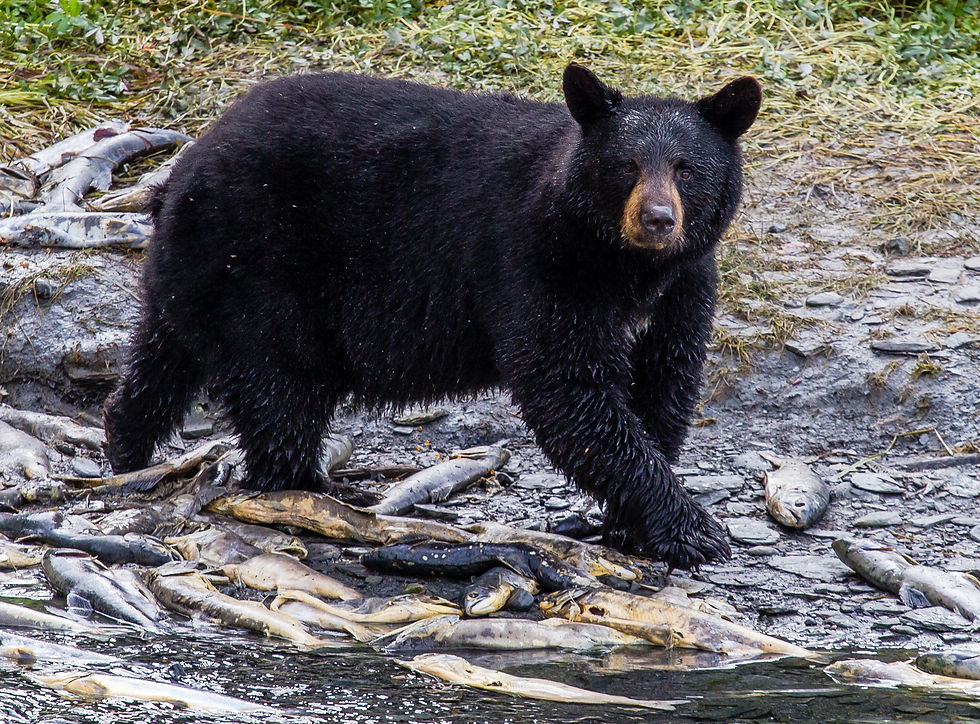
Depositphotos
However, there have been times over the past 30 years when additional action was necessary to avoid becoming dinner.
In a situation where you come face to face with a bear, gather several people side by side, waive your arms and yell at the top of your voice.
If that doesn’t work, try pelting the bear with a barrage of large rocks. I know this sounds crazy, but back in my younger crazier days we did this on two different occasions when bears tried to steal our fish.
Whatever you do, do not run or climb a tree. The bear is much better at both and can easily run you down or pull you out of a tree. Slowly backing away is a much better idea.
Seriously, keep in mind that no fishing spot is worth a dangerous encounter with a bear. It is always best to back away and fish another day.
Stream Etiquette
There may be some competition for access to the best water which is fine if you practice good stream etiquette.
This means the first group on a particular pool has the right to fish that pool; do not cut in on another fisherman’s spot without their permission.
This will royally hack them off and may lead to an aggressive response (yelling / threats / broken fly rods / black eyes, etc.).
If you act like a bum, expect to be treated like a bum, you deserve it.
Also try to fish in groups of 2-3 so several people can hold the spot on the stream while another person is landing a fish.
If another group shows up and starts edging in on your location, firmly but diplomatically explain:
· Your group was here first and you are not giving up your spot
· The river is big place with a lot of other locations where they can fish including well away from you on either side
· When you briefly go to shore to land a fish, the spot is still yours and you will be back
Know Your Water and Presentation of the Fly
Some fishing articles will tell you that aggressively stripping a fly is a good way to catch salmon. I have not found this to be the case; stripping a fly just snags fish which can lead to a broken rod or loss of your fly line.
In my experience salmon want the fly presented on a dead drift or sometimes with a very slight up and down jigging motion.
The strike will be very subtle. Your line may pause slightly, move to one side, twitch or just not look right. An obvious strike is rare. This is because salmon are not actively feeding when they enter freshwater. They will just pick up the fly for a brief moment, then spit it out.
It is also necessary to present the fly at the proper depth. An unweighted fly may not catch fish on some Alaska rivers. If the current is strong or the water is up it might also be necessary to add a split shot to help get the fly down to the fish.
Finally, you must be where the fish are located. The majority of the water in the river or stream will not hold fish. They will blow right through riffles and pocket water that would typically have trout and only stop in pools before making the next leg of their spawning run. Also watch for fish that are breaking the water and cast to them; there are usually others nearby.
The All Important Fly
When salmon start migrating up the streams to spawn, they stop eating except to sporadically consume the eggs of other salmon, especially the eggs of other salmon species.
It is sad to say, but we have found that most salmon fly patterns simply do not work. They are designed to catch fishermen rather than fish.
Following are examples of what does work. This is a new fly from Bear River Tackle that we tested on Coho and Chum salmon in Southeast Alaska last year. The flies are 4-4.5 inches long, weighted and tied on a #2 extra strong hook for big fish. They are also patented and extremely effective.
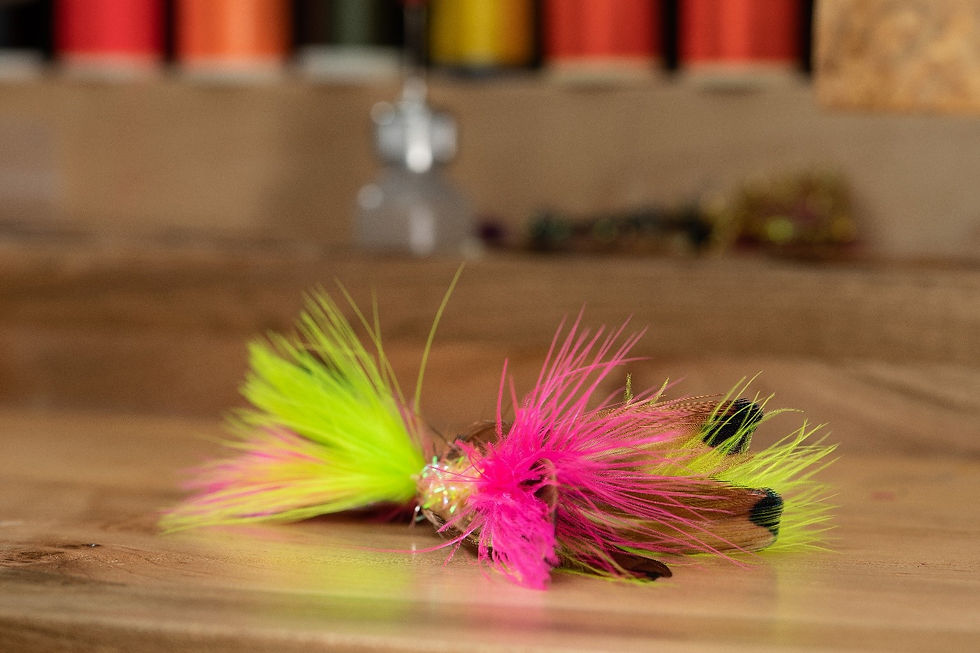
Salmon Slayer Family Red-DVL Chartreuse & Pink

Salmon Slayer FamilyRed-DVL Pink & Cerise
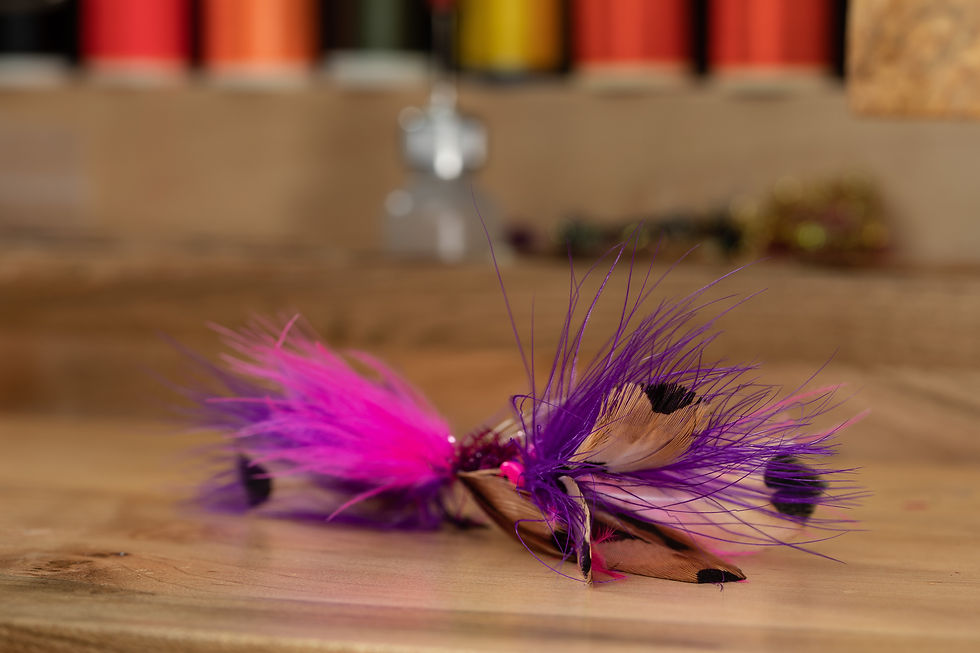
Salmon Slayer Family Gold-EY Fuchsia & Purple
These radical new flies are unlike anything in the world and are deadly for salmon. They will likely also catch other large fish such as stripers, pike, bass, redfish, lake trout, etc. but have not yet been tested on these fish.
You can find more information about Bear River Tackle including underwater video, fishing tips and the flies discussed in this article by searching for Bear River Tackle on the internet or putting https://bearrivertackle.com in the search bar. While you are there check out the Trophy Gallery and Newsletter to follow along on our adventures and see some of the fish that have been caught with Bear River Tackle flies.
What is Possible When Everything is Right
There are a lot of stories about people that were happy to catch 4-5 Coho Salmon each day on flies during a guided fishing trip.
In comparison, during a four day do-it-yourself trip last year, I landed and released 65 Coho Salmon and 15 Chum Salmon using the techniques covered in this article and Bear River Tackle flies.
Rain set up great river conditions and Bear River Tackle flies delivered the goods!

Photo by Glenn Personey
Honestly, it doesn’t get any better than this.
Copyright Bear River, LLC – January 2020. All Rights Reserved






Comments